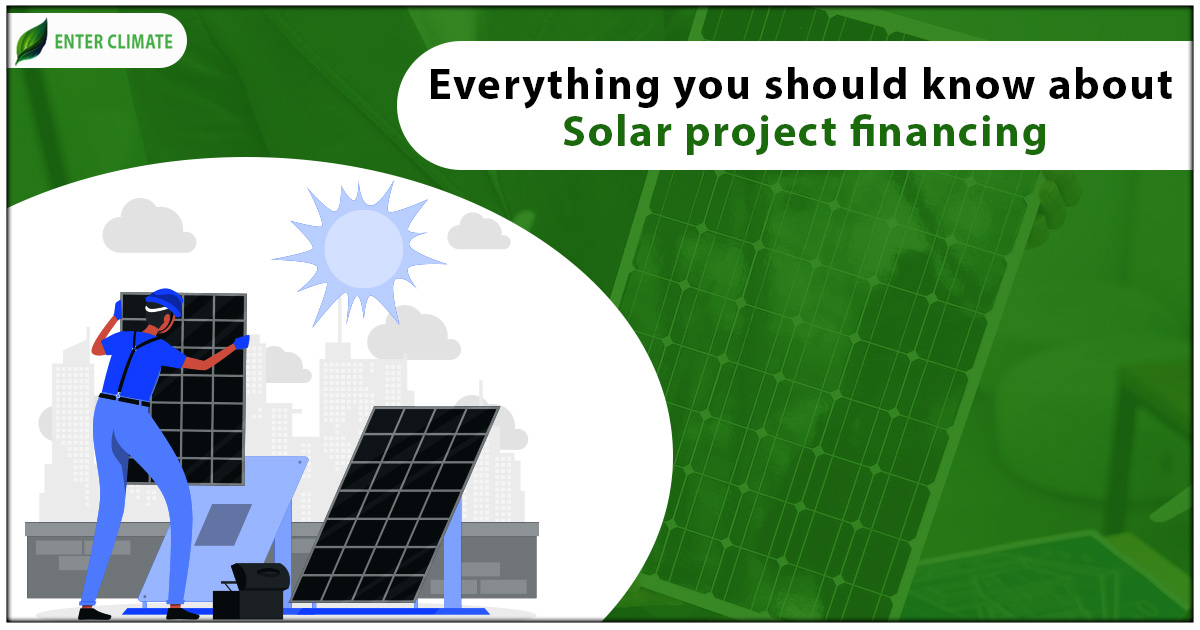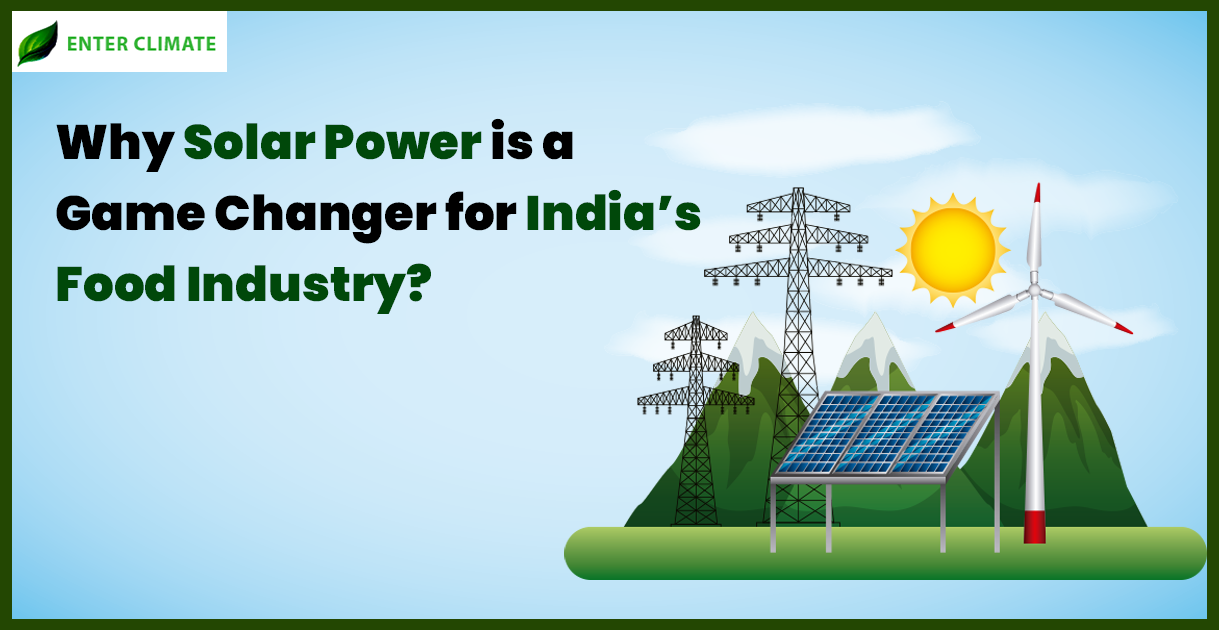Everything you should know about solar project financing
 19 Jun, 2023
19 Jun, 2023 
The Indian government is actively promoting its citizens’ adoption of solar energy. To make it easier for people to embrace solar energy, public sector and private banks have been instructed by the Ministry of Finance to offer loans at reasonable costs, following the guidelines set by the Government of India and the Reserve Bank of India. Installing solar energy systems has numerous advantages, including reducing pollution, decreasing reliance on the electrical grid, and lowering electricity bills. However, many individuals need more time to switch to solar energy due to the upfront installation costs. While the investment pays for itself within 3-4 years, not everyone can afford the total cost upfront. If the large lump sum payment is a concern, this is where solar project financing comes into play. Continue reading this article to find essential information about solar project financing and its benefits.
Current Scenario in India
In terms of the market, India’s renewable energy sector is the fourth most attractive market in the world. As of 2019, India ranked fifth in wind power, fifth in solar power, and fourth in overall renewable power capacity. The sector has become attractive to investors due to government support and improved economics. Renewable energy will be crucial in meeting its energy demand independently, which is expected to reach 15,820 TWh by 2040. By 2030, the government plans to establish a renewable energy capacity of 523 GW, including 73 GW from hydro sources.
Financing Structure of solar project financing
Equity Financing
Regarding the structure of solar project financing, the equity portion of the investment can come from the developer or equity partners who agree to purchase the projects. Equity partners can be individual firms, developers, equity funds managed by management firms, bank equity fund managers, or pension fund managers. These equity funds can be used as the initial capital for project construction following the completion of design, environmental studies, legal analysis, permit applications, and grid connection applications. Equity represents around 15-30% of the total project investment cost.
Debt Financing
The debt portion of the investment is typically provided by an investment bank, offering project finance or leasing finance. Debt financing constitutes the more significant portion of the investment, typically ranging from 70% to 85% of the total project cost. Large corporations and utilities may develop solar plants using their own funds without the need for project finance, utilizing their corporate balance sheets. However, they still conduct due diligence reviews before committing funds to the project.
Major Solar Project Financing Institutes in India
Major solar project financing institutes in India are as follows:
- Indian Public Sector and Private Banks: State Bank of India (SBI), Punjab National Bank, Bank of Baroda, Central Bank, ICICI, Yes Bank, Axis Bank. These banks offer debt finance for various solar projects at interest rates ranging from 9.5% to 10.5% per annum. SBI is set to finance the largest capacity of 15,000 MW among public sector banks.
- IREDA (Indian Renewable Energy Development Agency): A Non-Banking Financial Institution (NBFC) under the Ministry of New and Renewable Energy (MNRE). IREDA[1] provides term loans for renewable energy and thermal energy efficiency projects. They offer finance up to 75% of the solar project cost, conduct credit ratings, and determine interest rates based on risk assessment. IREDA also sources funds from international agencies and banks.
- IFC (International Finance Corporation): The financing division of the World Bank, IFC provides debt and investment support to solar projects in India. They offer advisory services to state governments and invest in solar companies.
- ADB (Asian Development Bank): Actively involved in financing solar projects in India, ADB is a primary loan provider for solar power projects. They offer financing support under the India Solar Generation Guarantee Facility (ISGGF) and provide direct financing and guarantees for projects over 25 MW.
- REC (Rural Electrification Corporation): Focuses on promoting solar energy projects; REC provides financial assistance for power generation projects. They propose a debt-to-equity ratio of 70:30 for private-sector borrowers and follow the lead banks’ ratio for other cases.
- KfWBank (KreditanstaltfuerWiederaufbau):,KfWis a German bank that provides financing support through KfW Development Bank for solar photovoltaic investments in India.
- NBFCs (Non-banking financial companies): Infrastructure Leasing & Financial Services Limited (IL&FS), SBI Macquarie, Taurus Infrastructure Fund, Rural Electrification Corporation (REC), Power Finance Corporation (PFC), Larsen & Toubro (L&T), SBI Capital Markets, BNP Paribas, and other NBFCs are involved in debt financing for solar projects.
- Other international financers: The World Bank-Clean Technology Fund (CTF), European Investment Bank (EIB), and EXIM Bank also provide financial support for solar projects in India.
Recent Government Initiatives
Government Initiatives for the renewable energy sector are as follows:
- In the Union Budget, the Ministry for New and Renewable Energy allocated Rs. 5,753 crores (US$ 788.45 million) and Rs. 300 crores (US$ 41.12 million) for the ‘Green Energy Corridor’ scheme.
- An additional capital infusion of Rs. 1,000 crores (US$ 137.04 million) was provided to the Solar Energy Corporation of India (SECI) and Rs. 1,500 crore (US$ 205.57 million) to Indian Renewable Energy Development Agency under the Union Budget.
- Customs duty on solar inverters increased from 5% to 20%, and solar lanterns increased from 5% to 15% to promote domestic production.
- SJVN Limited, a PSU under the Ministry of Power, entered an MoU with Indian Renewable Energy Development Agency Ltd. (IREDA) to provide services for green energy projects.
- A production-linked incentive (PLI) scheme worth Rs. 4,500 crores (US$ 610.23 million) was announced for high-efficiency solar PV module manufacturing.
- Energy Efficiency Services Limited (EESL) and the Department of New & Renewable Energy (DNRE), Goa, signed an MoU to discuss the roll-out of India’s first Convergence Project in the state.
- An inter-ministerial committee was established under NITI Aayog to focus on energy modelling through the India Energy Modelling Forum (IEMF).
- India aims to add 30 GW of renewable energy capacity along its western border, specifically in Gujarat and Rajasthan.
- The thermal power plant in Rajghat, Delhi, will be shut down and developed into a 5,000 KW solar park.
- The Government of India plans to implement a US$ 238 million National Mission on advanced ultra-supercritical technologies for cleaner coal utilization.
- Custom and excise duty benefits were provided to the solar rooftop sector by the Ministry of New and Renewable Energy (MNRE), reducing the setup cost and promoting growth.
- Indian Railways is implementing energy-efficient measures and maximizing the use of clean fuel to reduce emission levels by 33% by 2030.
Eligibility Criteria for Solar project financing
Eligible Entities/Borrowers for the solar project financing scheme:
- Resident Indian Citizens, Non-resident Indians (NRIs), Persons of Indian Origin (PIOs), and Overseas Citizenship of India (OCI) holders are eligible.
- Applicants must own an independent house without loans from other banks against the same property.
- Borrowers can apply individually or jointly with eligible family members as per home loan scheme guidelines.
- All proposed co-owners of the property must join as applicants if the property is taken as collateral.
Age Criteria:
- The minimum entry age is 18 years.
- The maximum age at the end of repayment is 75 years for both salaried and non-salaried borrowers.
- Individuals with a regular source of income after 60 years can be considered for repayment beyond 60 years of age.
- Maximum age and tenure considerations apply only to applicants whose income is considered for loan repayment.
- For joint applicants, if only one person’s income is considered, only their age is relevant for determining the maximum repayment tenure.
Evaluation of Project for Funding by Lenders and Financing Institutes:
- Both equity and debt finance investors assess the project’s legal, permitting, consent, and technical due diligence areas.
- Equity stage due diligence is based on preliminary technical information, while project finance due diligence occurs at a later stage with detailed technical information.
Developer Tasks:
- Identifying sites with the best resources.
- Negotiate land use.
- Conduct initial solar resource analysis.
- Complete an Environmental Impact Assessment (EIA).
- Perform initial layout, design, and equipment selection.
- Apply for and obtain planning permits and consents.
- Apply for and receive grid connection offers or letters of intent.
- Apply for the feed-in tariff (FiT) and/or power purchase agreements (PPAs).
Due Diligence
Whether it is a solar, hydrogen,wind or any other type of technology, due diligence is essential for the legal, technical and financial auditing of renewable energy projects. It allows the developers, owners, investors, financial institutions, etc., who are involved in a transaction to assess the risk involved in each investment.The following are the factors considered during the due diligence phase in the case of solar project financing:
- Legal due diligence assesses permits and contracts.
- Insurance due diligence examines insurance policies and coverage gaps.
- Technical due diligence evaluates the technology, integration, and technical aspects of permits and contracts.
Technical Due Diligence Assessment Areas:
- Sizing of the PV plant, layout, PV modules, mounting or trackers, and inverters.
- Electrical design layout, sizing, cable losses, cable placement, connectors, earthing, and protection systems.
- Technology review of major components, including suitability, integration, track record, quality, compliance, warranties, and design life.
- Energy yield assessments, considering assumptions, solar irradiation data, shade, degradation, uncertainty analysis, and performance ratio.
- Contract assessments, identifying risks, construction timelines, warranty and guarantee positions, and financial model assumptions.
Developer’s Effort and Requirements:
- Considerable effort is required to meet lenders’ requirements during the due diligence process.
- Realistic financial models with contingencies and a sensible construction program are essential.
- The process may identify risks and require design or component usage changes to make the project “bankable” for lenders.
Conclusion
The government is dedicated to increasing the utilization of clean energy sources and is already engaged in various large-scale sustainable power projects while actively promoting green energy. Moreover, renewable energy has the potential to generate numerous employment opportunities, particularly in rural areas. Additionally, there are plans to establish around 5,000 Compressed Biogas plants across the country by 2023. Projects concerned about solar project financing and its criteria must seek expert consultation in order to get the above-mentioned government scheme benefits and to complete the documentation and other procedural legalities in a hassle-free method.
FAQ
Solar project financing allows individuals and businesses to install solar energy systems without paying the full upfront cost. Solar project financing options make solar power more accessible and affordable to a wider range of individuals and organizations. Investing in solar energy systems can provide a solid return on investment (ROI) over the long term.
•Resident Indian Citizens, Non-resident Indians (NRIs), Persons of Indian Origin (PIOs), and Overseas Citizenship of India (OCI) holders are eligible.
•Applicants must own an independent house without any existing loans from other banks against the same property.
•Borrowers can apply individually or jointly with eligible family members as per home loan scheme guidelines.
•All proposed co-owners of the property must join as applicants if the property is taken as collateral.
The Ministry of New and Renewable Energy (MNRE) has set an ambitious goal of establishing renewable energy capacities of 227 GW by 2022, including 114 GW for solar, 67 GW for wind, and additional capacities for hydro and bioenergy, among others. The renewable energy sector in India is projected to attract investments amounting to US$ 80 billion within the next four years.
Ladakh witnessed the largest solar power project under the ‘Make In India’ initiative, with a capacity of 1.5 MW at Leh Indian Air Force Station.
The government aims to achieve a total renewable energy capacity of 227 GW by 2022, including 114 GW of solar capacity and 67 GW of wind power capacity, surpassing its original target of 175 GW based on the Paris Agreement.
Read our Article: How To Start A Renewable Energy Business In India?













